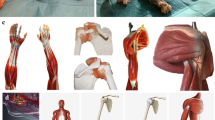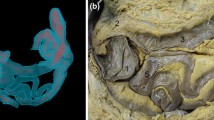Abstract
Purpose
Digital anatomy is a novel emerging discipline. Use of virtual reality brings a revolution in educational anatomy by improving retention and learning outcomes. Indeed, virtual dissection is a new learning tool for students and surgeons. Three-dimensional vectorial models of the human body can be created from anatomical slices obtained by lengthy series of cryosection from the visible human projects. The aim of this paper is to show how these mesh models could be embedded into an Acrobat® 3dpdf interface, to produce an easy-to-use fully interactive educational tool.
Methods
The learning of this method and its practical application were evaluated on a multicentric cohort of 86 people divided into 3 groups, according to the duration of their training (1, 2 or 3 days, respectively). Participants learned how to use the Mesh tool and how to model 3D structures from anatomical sections. At the end of the training, they were given a survey form. Participants were also asked to rate the training (Poor; Average; Good; Very Good; Excellent).
Results
Ninety four percent of the subjects rated the device as excellent and would continue to use digital anatomy in their practice.
Conclusion
This result is the Diva3d® virtual dissection table, a powerful educational tool for anatomists and students. It could also be the basis of future simulation tools for hand surgeons training.






Similar content being viewed by others
References
Sugand K, Abrahams P, Khurana A (2010) The anatomy of anatomy: a review for its modernization. Anat Sci Educ 3:83–93
Older J (2004) Anatomy: a must for teaching the next generation. Surg J R Coll Surg Edinb Irel 2:79–90
Chapman SJ, Hakeem AR, Marangoni G, Prasad KR (2013) Anatomy in medical education: perceptions of undergraduate medical students. Ann Anat 195:409–414
McMenamin PG, McLachlan J, Wilson A, McBride JM, Pickering J, Evans DJR, Winkelmann A (2018) Do we really need cadavers anymore to learn anatomy in undergraduate medicine? Med Teach 40:1020–1029
Zhang S-X, Heng P-A, Liu Z-J (2006) Chinese visible human project. Clin Anat N Y 19:204–215
Linke R, Leichtle A, Sheikh F, Schmidt C, Frenzel H, Graefe H, Wollenberg B, Meyer JE (2013) Assessment of skills using a virtual reality temporal bone surgery simulator. Acta Otorhinolaryngol 33:273–281
Darras KE, Forster BB, Spouge R, de Bruin AB, Arnold A, Nicolaou S, Hu J, Hatala R, van Merriënboer J (2019) Virtual dissection with clinical radiology cases provides educational value to first year medical students. Acad Radiol 27(11):1633–1640
Uhl J-F, Park JS, Chung MS, Delmas V (2006) Three-dimensional reconstruction of urogenital tract from visible Korean Human. Anat Rec A Discov Mol Cell Evol Biol 288:893–899
J F (2017) Tridimensional vectorial modeling of the heart and coronary vessels from the anatomical slices of the Korean visible human. J Hum Anat 1
Park JS, Chung MS, Hwang SB, Lee YS, Har D-H, Park HS (2005) Visible Korean human: improved serially sectioned images of the entire body. IEEE Trans Med Imaging 24:352–360
Lozanoff S, Deptuch JJ (1991) Implementing Boissonnat’s method for generating surface models of craniofacial cartilages. Anat Rec 229:556–564
Yuan Y, Qi L, Luo S (2008) The reconstruction and application of virtual Chinese human female. Comput Methods Progr Biomed 92:249–256
Ackerman MJ (1999) The visible human project: a resource for education. Acad Med J Assoc Am Med Coll 74:667–670
Fang B, Wu Y, Chu C, Li Y, Luo N, Liu K, Tan L, Zhang S (2017) Creation of a virtual anatomy system based on Chinese visible human data sets. Surg Radiol Anat SRA 39:441–449
Park JS, Chung MS, Hwang SB, Shin B-S, Park HS (2006) Visible Korean Human: its techniques and applications. Clin Anat N Y 19:216–224
Guimarães B, Dourado L, Tsisar S, Diniz JM, Madeira MD, Ferreira MA (2017) Rethinking anatomy: how to overcome challenges of medical education’s evolution. Acta Med Port 30:134–140
Shin DS, Chung MS, Park HS, Park JS, Hwang SB (2011) Browsing software of the visible Korean data used for teaching sectional anatomy. Anat Sci Educ 4:327–332
Chung BS, Shin DS, Brown P, Choi J, Chung MS (2015) Virtual dissection table including the visible Korean images, complemented by free software of the same data. Int J Morphol 33:440–445
Glinkowski W, Ciszek B (2007) WWW-based e-teaching of normal anatomy as an introduction to telemedicine and e-health. Telemed J E-Health Off J Am Telemed Assoc 13:535–544
Paech D, Giesel FL, Unterhinninghofen R, Schlemmer H-P, Kuner T, Doll S (2017) Cadaver-specific CT scans visualized at the dissection table combined with virtual dissection tables improve learning performance in general gross anatomy. Eur Radiol 27:2153–2160
Bork F, Stratmann L, Enssle S, Eck U, Navab N, Waschke J, Kugelmann D (2019) The benefits of an augmented reality magic mirror system for integrated radiology teaching in gross anatomy. Anat Sci Educ 12:585–598
Darras KE, Spouge R, Hatala R, Nicolaou S, Hu J, Worthington A, Krebs C, Forster BB (2019) Integrated virtual and cadaveric dissection laboratories enhance first year medical students’ anatomy experience: a pilot study. BMC Med Educ 19:366
Asensio Romero L, Asensio Gómez M, Prats-Galino A, Juanes Méndez JA (2018) 3D models of female pelvis structures reconstructed and represented in combination with anatomical and radiological sections. J Med Syst 42:37
Jain N, Youngblood P, Hasel M, Srivastava S (2017) An augmented reality tool for learning spatial anatomy on mobile devices. Clin Anat N Y 30:736–741
Condino S, Turini G, Parchi PD, Viglialoro RM, Piolanti N, Gesi M, Ferrari M, Ferrari V (2018) How to build a patient-specific hybrid simulator for orthopaedic open surgery: benefits and limits of mixed-reality using the Microsoft HoloLens. J Healthc Eng 2018:5435097
Christidi F, Karavasilis E, Samiotis K, Bisdas S, Papanikolaou N (2016) Fiber tracking: a qualitative and quantitative comparison between four different software tools on the reconstruction of major white matter tracts. Eur J Radiol Open 3:153–161
Acknowledgements
Pr. PJin Seo nark in Dongguk university and Dr. Chung in Ajou university (South Korea) for the data used from the Visible Korean’ project.
Funding
No funding sources.
Author information
Authors and Affiliations
Contributions
R. DUKAN: Manuscript writing/editing, Data analysis. J-F UHL: Protocol/project development, Data collection, Data management, Manuscript writing/editing, Supervising. V. Delmas: Protocol/project development, Data collection. M. Chahim: Protocol/project development, Data collection. E. H. MASMEJEAN: Manuscript writing/editing, supervising.
Corresponding author
Ethics declarations
Conflict of interest
No conflict of interest for each author.
Additional information
Publisher's Note
Springer Nature remains neutral with regard to jurisdictional claims in published maps and institutional affiliations.
Rights and permissions
About this article
Cite this article
Dukan, R., Uhl, JF., Delmas, V. et al. Three-dimensional reconstruction of the upper limb from anatomical slices of the Korean visible human: simulation and educational application. Surg Radiol Anat 43, 547–558 (2021). https://doi.org/10.1007/s00276-021-02704-x
Received:
Accepted:
Published:
Issue Date:
DOI: https://doi.org/10.1007/s00276-021-02704-x




